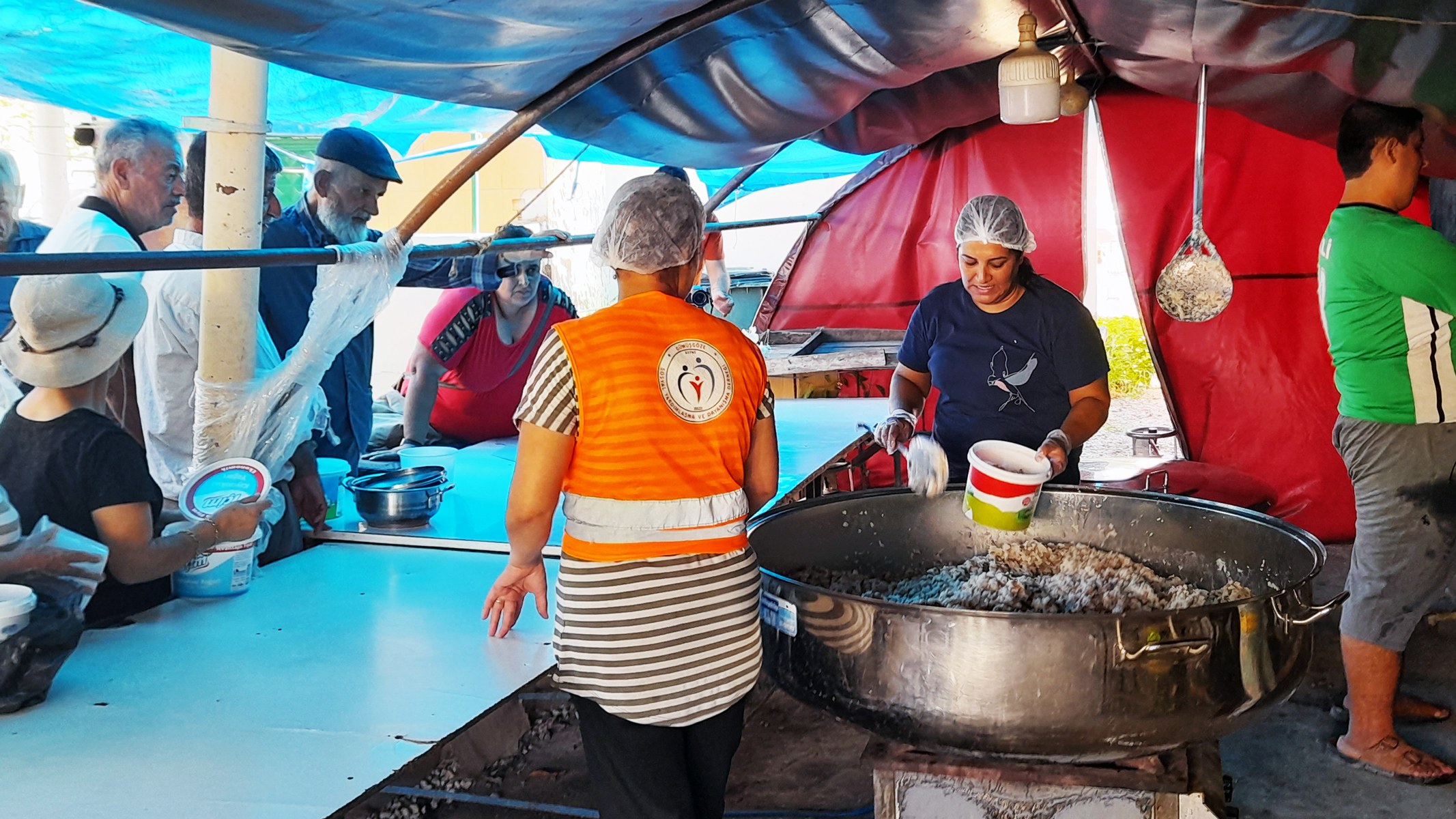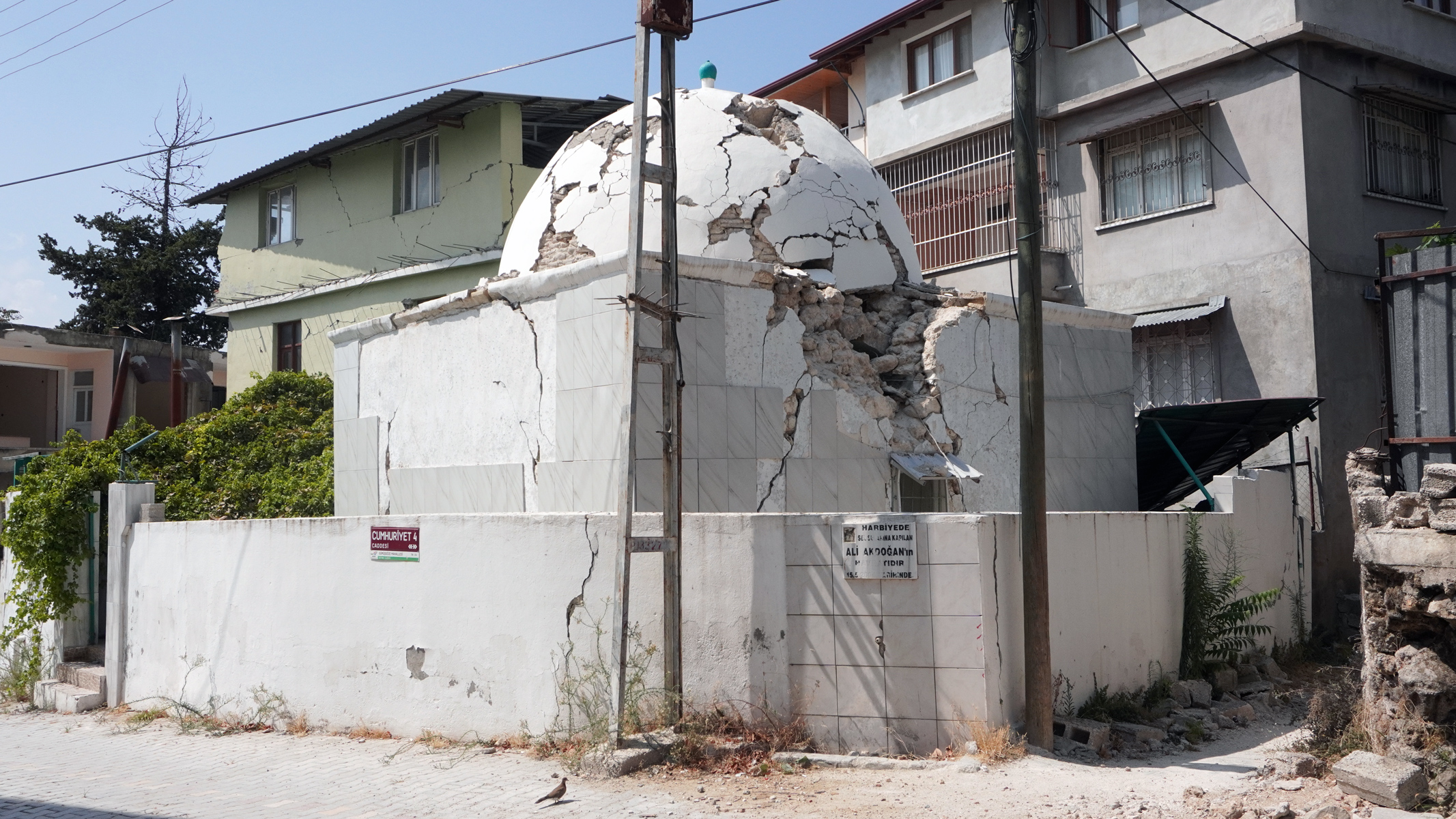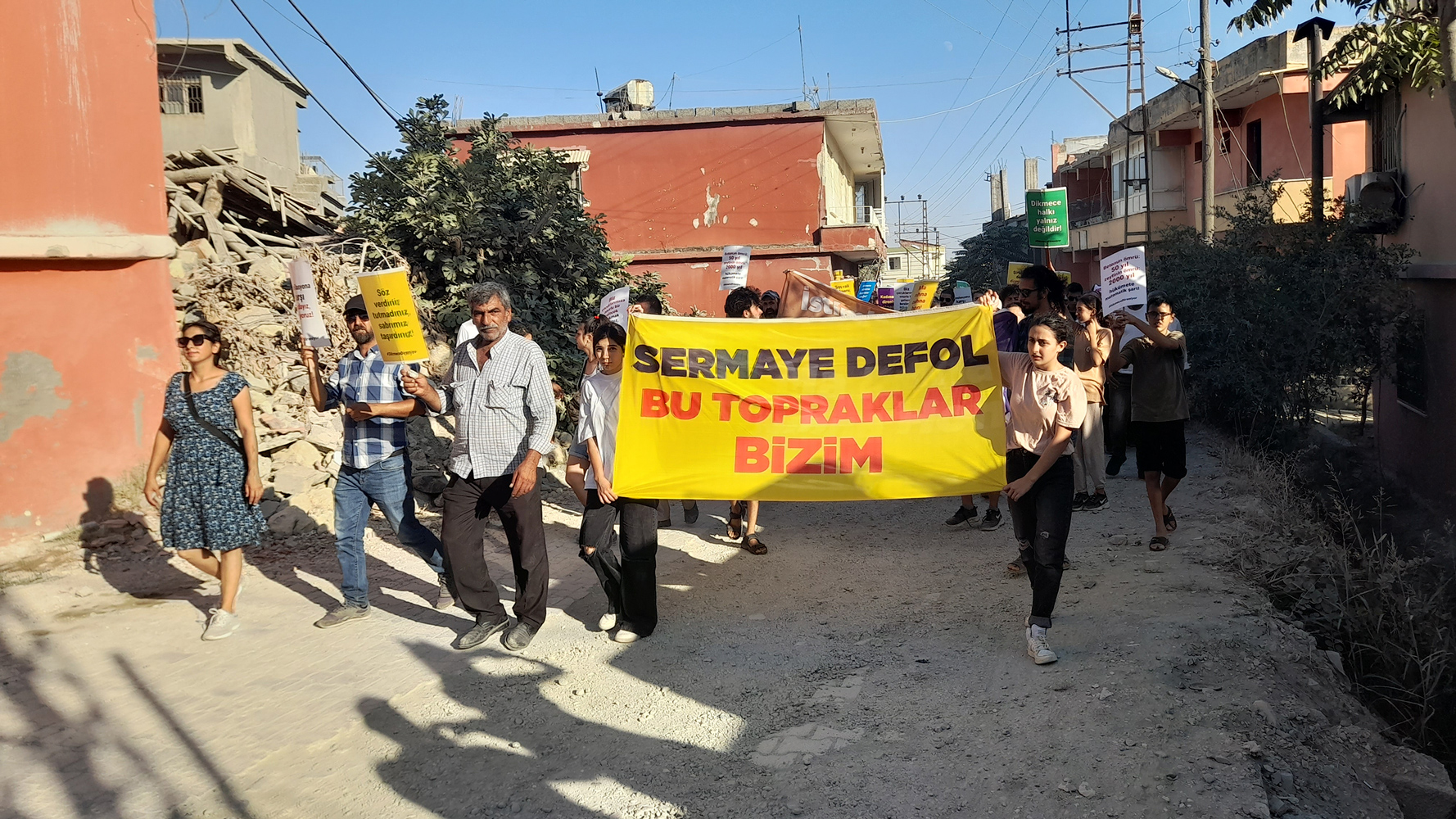Dossier
“I don’t know if we’ll ever get Antakya back”: minorities struggle to survive Turkey’s earthquakes
Today, nine months later, they are still serving daily meals to some 1,200 residents who cannot cook at home because their homes were destroyed by the earthquake. “As time passed, aid became less and less and people’s needs changed,” explains Aşkar. “We provide food, but many people also come to socialize, for lack of other spaces. People can’t visit their neighbours’ houses, and children can’t play in parks. They miss a meeting point,” she says. Askar covers the day’s meal, rice and meat cooked in butter, with a large cloth to keep the dust off it. Dust is a current feature of Gümüşgöze, a neighbourhood of 4,000 inhabitants in Antakya. It invades streets and tree leaves, quickly settling on cars, tents or anyone standing still on the street for more than a minute. Unlike other devastated areas of the city, where not a single building remains standing, in Gümüşgöze the streets of the neighbourhood are still discernible. Children play among crumbling concrete blocks and iron protruding from the ground. Some shops have reopened despite obvious damage, but commercial activity is minimal. Many inhabitants are out of work after the quake and spend the day in front of their half-collapsed houses, waiting for who knows what.
“Are you from the government?”, a neighbour asks when he sees a stranger’s face. In the face of refusal, he continues to ask. “Do you have any information about what the government will do?”. This is the question that runs through the whole neighbourhood: “What now?”.
 Neslihan Aşkar and Selda Aldiç give food to Gümüşgöze residents. / Photo: L. V.
Neslihan Aşkar and Selda Aldiç give food to Gümüşgöze residents. / Photo: L. V.Of the buildings that did not collapse completely, 85% are severely damaged and need to be demolished. Several construction companies have divided up the removal of the rubble through public tenders to resell some of the materials from the buildings. Trucks from subcontractors start work in Gümüşgöze. As the machines remove rubble every day, a lorry drops water to keep dust at bay. The water soon runs out, however, and dust is everywhere again. Hardly anyone wears a mask, neither workers nor neighbours, despite scientists’ warnings about asbestos in the region.
Most families in the neighbourhood have lived in tents in their buildings’ gardens for nine months. People struggle to adapt to their new habitat and maintain customs: they tend plants, dry peppers and figs in the sun to make preserves, distill alcohol, and invite neighbours to have coffee in their courtyards. The government offered them temporary accommodation in container houses on the outskirts of the city. However, the residents of Gümüşgöze who survived the earthquake preferred to stay in their neighbourhood, where they all know each other: “The container cities are far away from everything. It’s very hot in these houses. After all, they are made of plastic: it’s not cleaner either. We don’t know anyone there, we don’t feel safe leaving the children playing there,” explains Selda Aldıç, a neighbourhood resident and member of the solidarity kitchen.
Gümüşgöze is a neighbourhood inhabited by Alevis, a religious minority close to Shi’ism. It has a population of between 15 and 20 million people in Turkey as a whole. For historical and political reasons they are generally progressive, and their rituals are heterodox. They have suffered rejection and persecution from the Sunni majority in Anatolia, with several pogroms in the 1970s, 1980s, and 1990s. Today they are not recognized by the state and receive no support to maintain their cemevis, their centres of worship and assembly. Depending on the region and origin of the members, Alevism has a variety of traditions and rituals. Alevis are present on the Aegean coast, in Anatolia, in the Kurdish regions and in the south of the country. In Gümüsgöze live Arab Alevis, also called Alawites, or Nusayrites, although the latter term is derogatory. Arab Alevis differ in origin, language, and religious and social practices from Turkish and Kurdish Alevis. Both branches agree in their proximity to Shi’ism and the centrality of Ali’s figure. But the Arab Alevis are found only in this region, in the province of Hatay. Unlike the Turkish or Kurdish Alevis, they do not pray and do not commemorate Shi’ism’s greatest holiday, Ashura, on the occasion of Imam Hussein’s martyrdom. Arab Alevis do not have cemevis either, but meet at the ziyaret (meaning ‘visit’ in Turkish), a small domed building considered sacred.
Alevi Arabs have Arabic as their mother tongue, although the younger generation speaks more Turkish than Arabic. On the streets, it is common to hear a mixture of both languages, even in the same sentence. “Basic needs and urgencies take precedence over other issues we have lost. More than a house, people want work, areas for children to play, a place to meet,” says Aşkar. “Antakya is a very diverse place. Here we grew up together, Christians, Muslims, Alevis, Jews,” she describes. Aşkar recounts in vivid detail the holidays celebrated by other faiths present in the city. They toasted at Christmas, painted eggs at Easter and hid them in the neighbourhood. They also shared food with neighbours at the end of Ramadan and on Jewish holidays. “Many of those who survived the earthquake have left the city. I don’t know if we will ever get Antakya back,” she laments.
 An earthquake-hit ziyaret temple in Gümüşgöze. / Photo: L. V
An earthquake-hit ziyaret temple in Gümüşgöze. / Photo: L. VFounded in 300 BC along the Orontes River, Antakya, formerly known as Antioch, has been ruled by Romans, Byzantines, Seljuks, Ottomans, and others. After the end of the Ottoman Empire, the territory fell under a French mandate as part of Syria. Turkey annexed it as a province in 1939, naming it Hatay. Because it was integrated into Turkey 17 years after the Republic’s founding, the province was exempted from the population exchange agreement with Greece. As a result, Hatay retained a large Greek Orthodox minority of some 10,000 inhabitants before the earthquake. Jews, Muslims, and Christians who had Arabic, Turkish, Greek, or Armenian as their mother tongues built their homes here. “When we talk about Antakya’s culture, we must also describe those around us to explain ourselves. It is not like in other cities like Istanbul, where everyone has separate lives. Here you celebrate your special days with everyone else,” explains Anna Maria Beylunioğlu, a political scientist and one of the initiators of the Nehna platform. Her project was the cultural loudspeaker for Arabic-speaking Christians in Antakya, but after 6 February it became a meeting point for all the communities that make up the city, to remember who they were, but also to discuss their future. “We knew each other’s rituals. There were no walls between us. We lived together, but each of us preserved our own rituals: separation was just a curtain,” she adds.
Earthquakes in the province in February likewise devastated these communities’ heritage. The dome and walls of the first-century Orthodox Church of Antakya collapsed completely. “History is erasing us again,” laments Fadi Hurigil, president of the church’s foundation. The Habib-i Nejjar mosque was also left in ruins, as was a Protestant church nearby. The earthquake also destroyed dozens of cemevis, Alevi prayer centres. For some of these minorities, the loss of prominent members of the communities had a devastating impact. Armenian families lost more than 50 community members, while Jews mourned the death of the congregation’s president and his wife, Saul and Tuna Cenudioğlu. 10 or so Jewish survivors left the city after the earthquakes, while the community helped those who could not afford to relocate. “The pain of thousands of lives lost is always in our hearts,” laments Yakup Cemel, a Jew from Antakya. “But it also saddens us that buildings part of the city’s memory are being destroyed. When I talk to my friends who live there or look at the city through photos and videos, I see nothing but huge rubble,” he laments. Cemel is one of the authors of the Jewish magazine Avlaremoz. After the earthquake, he published a devastating article in which he denounces that “the people of Antakya have been left without Antakya,” and describes the loss of the city’s historical and cultural legacy, as well as the few efforts of the government to recover it.
The earthquakes that devastated the region left some of the surviving population scattered across Turkey. Following the earthquake, the authorities announced that about 1.5 million people fled the 10 affected provinces. However, the actual number of people who have permanently left the region is unknown, as is the number of fatalities per province. While everyone says Antakya is one of the most severely affected cities, and it is clear that it was completely devastated by the quake, there are no figures for the loss of its population, which was previously around 200,000.
Longing for land, despite all difficulties
Some neighbours who fled after the earthquakes returned to Atankya because they could not adapt to other cities, far from their communities. “After the earthquake we moved to Eskişehir,” in north-western Turkey, “because we had no water or electricity. The people received us very well, they helped us a lot,” explains Rüya Balcı, a resident of Gümüşgöze. “But after a while we felt very lonely. My daughter cried a lot because she missed Antakya’s food. There is a different culture here, and there is a stronger sense of social contact than in other parts of the country,” she says. “We also had a language barrier, because although we speak Turkish too, nobody speaks Arabic there,” she adds.
The Nehna platform also initiated several culinary solidarity projects to help during the emergency, but they ended up being social meeting points. “What can I say? There are many people in the diaspora, they are not very happy, but they want to endure. They are not very happy, but they want to survive. They try to survive by cooking. It’s their way of coming home,” she says. “In Antakya, cooking is very particular. We make our own tomato or pepper concentrate, we always use our own olive oil”, she adds.
“People have lost their families, they have lost their homes, they have psychological problems. Most of them have not yet achieved economic stability. Children have logistical problems going to school. Many people don’t have a home, but they don’t want to leave here either,” explains Beylunioğlu. “With this context, it is obvious that the ethnic and religious composition of the city will be affected, because most people are out of the city and those who remain are trying to survive.”
Faced with the most immediate need to move forward, many residents complain about the lack of a space where they can all come together again and discuss how to rebuild the city. Although the government allows citizens to apply for financial assistance to construct prefabricated houses on their land, it is still very expensive for residents, and the waiting lists are endless. Antakya’s people feel abandoned by the state. “Many people try to build their own houses themselves or with the help of relatives abroad,” explains Beylunioğlu. “The demands of the population do not reach the state. We have space to discuss these issues, but their voice does not reach those at the top,” she adds.
For Celal Fırat, president of the Alevis Associations Federation (ADFE) of Turkey - an umbrella organization that brings together and represents all Alevi associations in the territory - the state did not fulfil its duties during the earthquake emergency, nor is it doing so now. “The housing issue, one of the most fundamental problems, has still not been solved; even if only temporarily, it is impressive,” he denounces. For Firat, Antakya’s diverse culture has not been completely lost, but clearly “weakened”. He complains that the government does not take the city’s diversity into account in its reconstruction plans. “They do not take into account the lifestyles, beliefs, culture, and historical geography of the communities, especially the Alevis,” he criticizes. “Many cemevis in the region were destroyed by the earthquake. The state did not contribute a single cent to the construction of these centres. Instead, they were built with the sweat of the Alevi community itself, and once again, our society is still looking for solutions to these problems,” he adds.
The Alevi community in Antakya has also been hard hit by the land expropriation programme, approved by the government days after the earthquake. This programme aims to facilitate the construction of new towns in supposedly safer areas. The authorities ordered the expropriation of land in the neighbourhood of Dikmece, located on a high plateau in Antakya, to build a new town.
 “Capital out, these lands are ours,” says the protest poster in Dikmece / Photo: L. V.
“Capital out, these lands are ours,” says the protest poster in Dikmece / Photo: L. V.These lands, mostly olive groves, belong to dozens of Alevi Arab families. They have organized themselves against the decision and have been resisting the government for more than a hundred days. The protest is supported by Kurdish and Turkish Alevis associations, who regularly travel to Antakya to support the struggle. To the Arabic cry of “Mah rehna nehna hon” (‘We are not leaving, we are here’), Dikmece residents have organized mass marches to publicize their cause. “We have gathered men, women, and children from the neighbourhood. We want to move forward together. We have the support of several (opposition) parties,” explains Selver Büyükkeleş, spokesperson for the Dikmece resistance. “The state cannot impose itself on this land where thousands of families live. Nor can it take over farmland that feeds thousands of people,” denounces Perihan Koca, a member of parliament for the pro-Kurdish left (HEDEP), who took part in one of the marches. For Celal Fırat, president of the Alevi associations, there is a clear discriminatory component in the government’s measures. However, he points out that minorities are not planning to leave Antakya: “The culture of coexistence is one of Antakya’s most important historical heritages. Those who embraced this heritage in the past - Arabs, Turks, Kurds, Armenians, Alevis, Sunnis, Christians... we are struggling.”
With support from:

